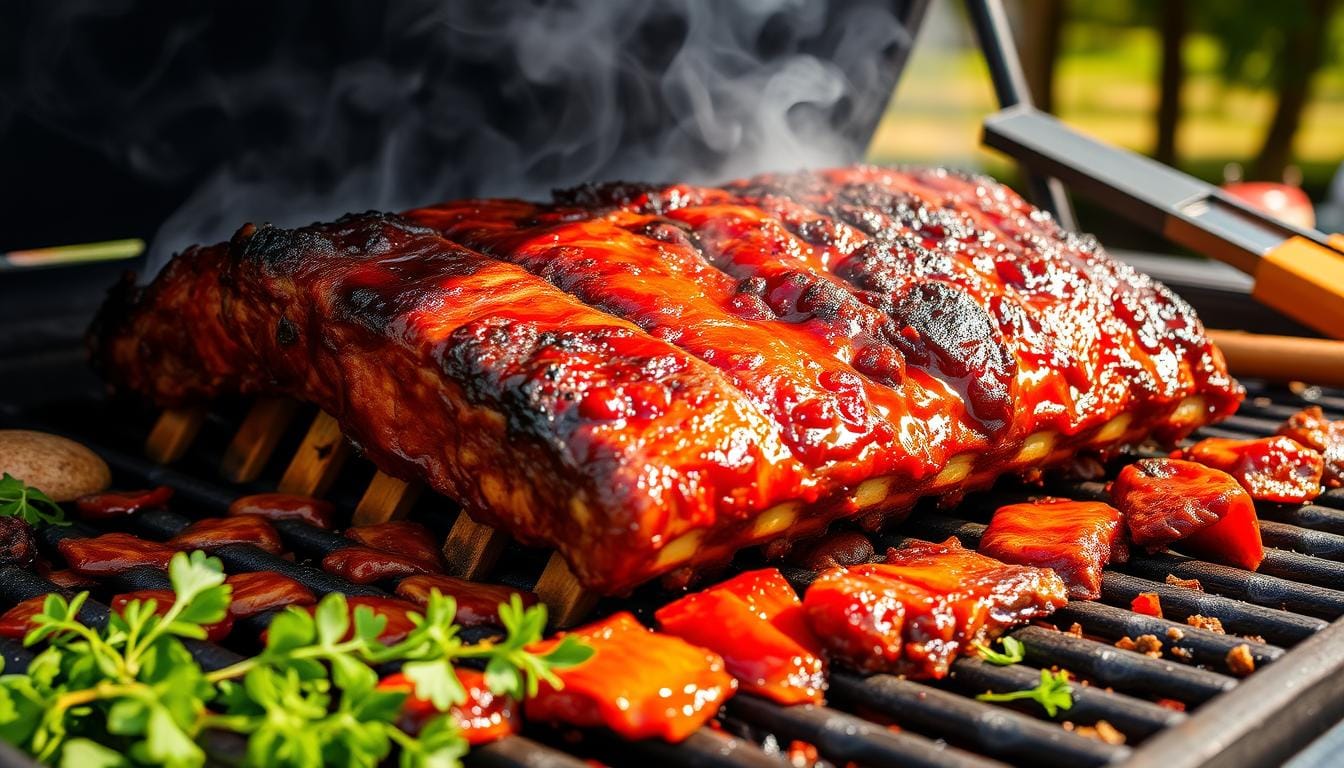Beef Ribs: Juicy, Tender, and Perfect for Grilling
Summer afternoons bring back memories of beef ribs on the grill. The smell of seasoned meat fills the backyard. It reminds me of family gatherings and weekend cookouts.
Beef ribs are more than a meal; they’re an experience that brings people together. Whether you’re a pro at grilling or just starting, these ribs promise a tasty journey into barbecue culture. They offer something special for every meat lover, from tender back ribs to rich short ribs.
Mastering barbecue ribs is about creating moments of joy. In this guide, you’ll learn how to turn simple beef ribs into a feast that will wow your family and friends.
Get ready to learn the secrets of perfectly grilled beef ribs. You’ll find out how to pick the best cuts and make flavor-packed rubs. These tips will take your barbecue to new heights.
Table of Contents
Understanding Different Types of Beef Ribs
Exploring beef ribs opens up a world of flavors and textures. Each cut offers something special for your grill.
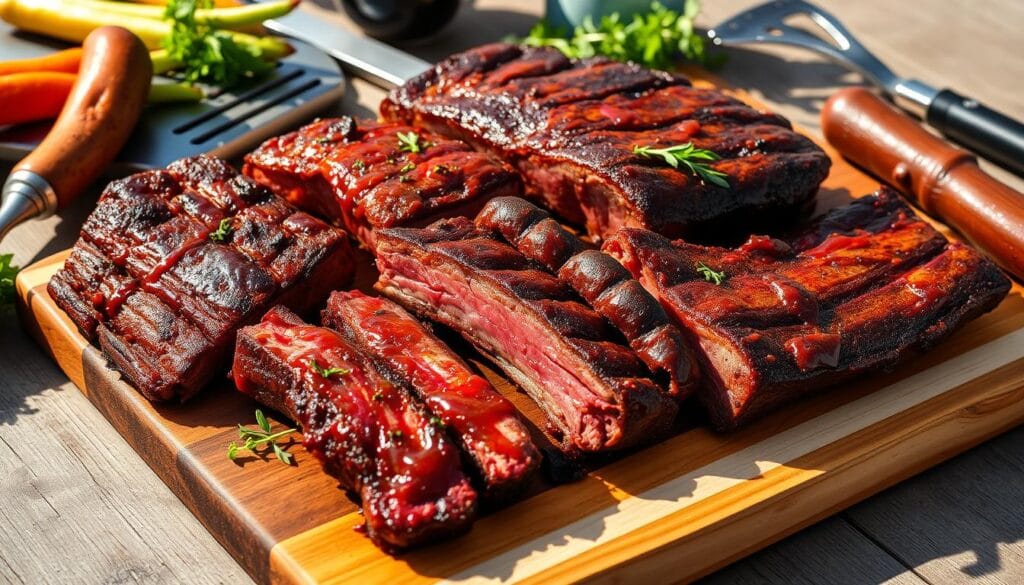
Beef ribs come in many varieties, each with its own charm. Grill masters often choose these cuts for their unique qualities.
Back Ribs vs. Short Ribs: A Flavor Showdown
Beef back ribs come from the rib cage’s top, near the spine. They’re leaner and have less meat than other cuts. These ribs are known for their tender meat and are often used in high-end barbecue recipes.
- Meat-to-bone ratio: Lower
- Fat content: Moderate
- Best cooking method: Low and slow smoking
Exploring Beef Plate Ribs
Beef plate ribs offer a meaty experience. Cut from the lower rib section, they have rich marbling and intense beef flavor. These ribs are a hit among barbecue fans who seek deep, rich tastes.
| Rib Type | Meat Yield | Fat Content |
|---|---|---|
| Beef Back Ribs | Low | Moderate |
| Beef Plate Ribs | High | Rich |
| Beef Short Ribs | Medium | High |
The Hidden Gem: Chuck Ribs
Chuck ribs are a hidden treasure for those who love strong beef flavor. Located near the shoulder, they offer a meaty goodness that can take your grilling to the next level.
“Know your ribs, and you’ll master the art of barbecue.” – Pit Master’s Wisdom
Knowing the differences between beef back ribs, beef short ribs, and beef plate ribs helps you choose the best for your next grilling adventure.
Selecting the Best Quality Beef Ribs for Grilling
Choosing the right beef ribs is key to a great barbecue. Quality is important for grilled ribs that impress everyone. Start by knowing what makes beef ribs stand out.
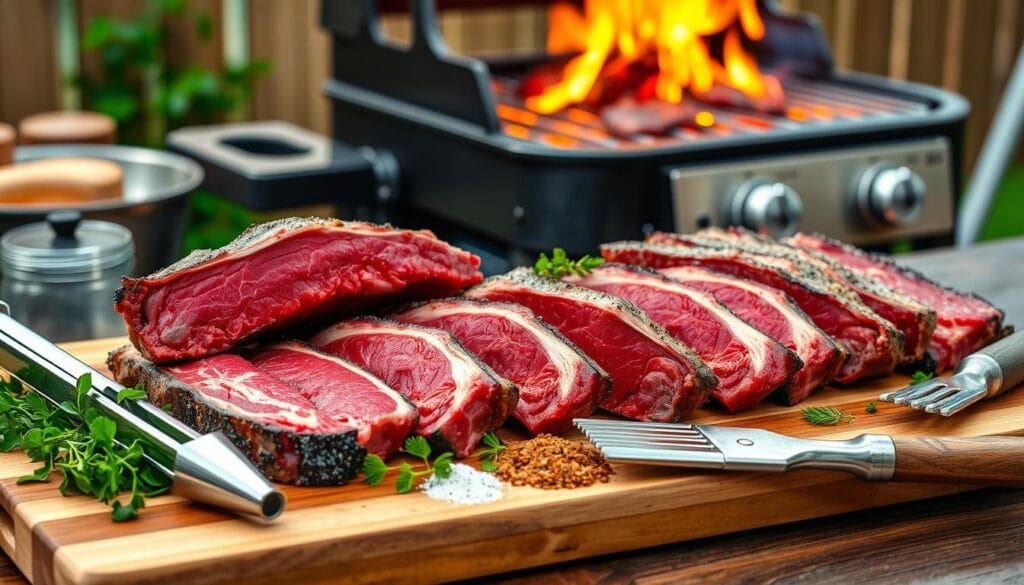
- Marbling: Look for consistent white fat streaks throughout the meat
- Color: Fresh beef ribs should have a bright red appearance
- Texture: Smooth, firm meat without excessive liquid or discoloration
Grass-fed versus grain-fed beef ribs have different tastes. Grass-fed ribs are leaner and taste stronger. Grain-fed ribs are richer and more tender.
“The secret to great barbecue ribs starts with selecting premium meat.” – Professional Pitmaster
Here are your best places to buy:
- Local butcher shops with specialized meat selections
- Farmers markets featuring local beef producers
- High-end grocery stores with dedicated meat departments
| Beef Rib Type | Marbling Quality | Recommended Use |
|---|---|---|
| Prime Beef Short Ribs | Excellent | Slow smoking and grilling |
| Choice Back Ribs | Good | Direct heat grilling |
| Select Plate Ribs | Fair | Braising and slow cooking |
By choosing high-quality beef ribs, you’ll improve your grilling skills. You’ll make barbecue experiences that everyone will remember and ask for more.
Essential Tools and Equipment for Cooking Beef Ribs
Preparing great grilled ribs needs more than just good meat and spices. The right tools make a big difference. Professional grill masters know that the right equipment is key to delicious smoked ribs.
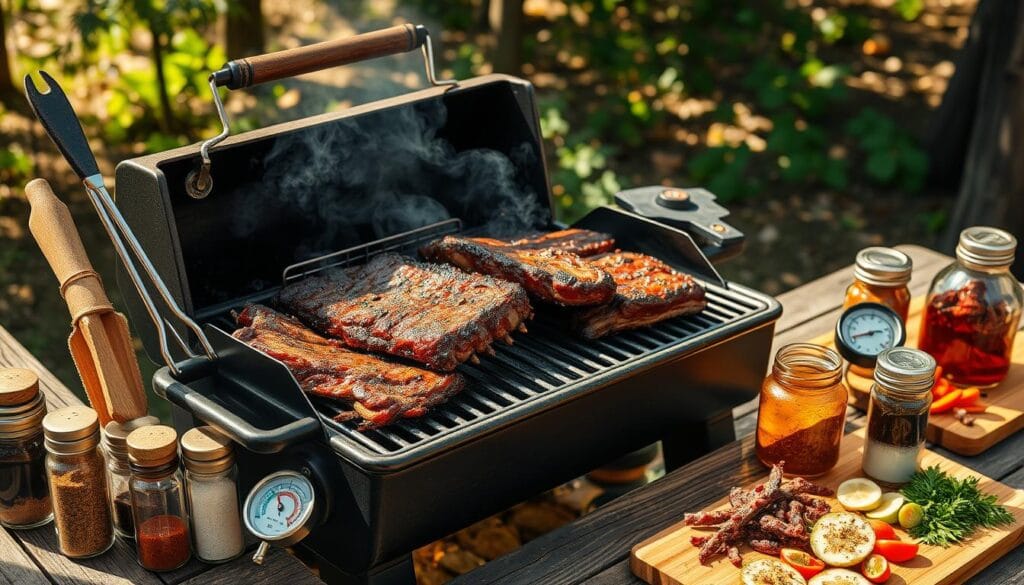
Getting quality grilling gear will make your cooking better. It ensures you get tasty results every time. Here are the must-have tools for every rib lover.
Grilling Equipment Essentials
- Charcoal grill for traditional smoky flavor
- Gas grill for precise temperature control
- Dedicated smoker for authentic barbecue ribs
- Wood chips for additional smoke and flavor
Temperature Control Tools
| Tool | Purpose | Recommended Type |
|---|---|---|
| Digital Meat Thermometer | Measure internal meat temperature | Wireless probe with smartphone connectivity |
| Grill Thermometer | Monitor cooking surface temperature | Analog or digital with multiple probe options |
Must-Have Accessories
Make your grilling better with these important accessories:
- Rib rack to maximize cooking space
- Heat-resistant gloves for safety
- Long-handled tongs for precise meat handling
- Basting brush for applying marinades
“The right tools don’t just cook ribs—they create culinary masterpieces.”
Pro tip: Quality tools are an investment in your grilling success. Choose durable, well-reviewed equipment that will serve you for many barbecue seasons.
Preparing Your Beef Ribs for the Perfect Cook
Getting your beef ribs ready for barbecue is an art form. It’s what makes a good cook great. Before cooking, proper preparation is key to the taste and texture of your ribs.
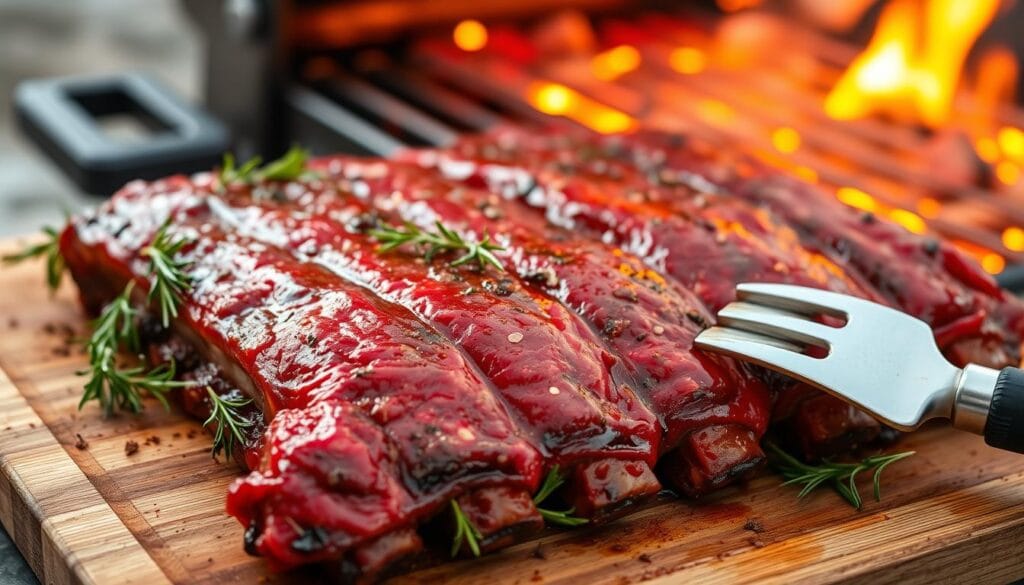
First, check your beef ribs carefully. Remove the tough membrane on the back. This step helps seasonings get in and makes the meat tender. Use a butter knife to lift the membrane at one corner. Then, grip it with a paper towel and pull it off smoothly.
- Trim excess fat to about 1/4 inch thickness
- Remove the silver skin membrane completely
- Pat the beef ribs dry with paper towels
- Allow ribs to reach room temperature before seasoning
When making your rib rub, spread it evenly over the ribs. Pro tip: Let the ribs sit with the rub for 30-60 minutes before cooking. This lets the flavors soak in deeply.
“Great barbecue ribs start with meticulous preparation” – Pit Master’s Secret
Temperature is important when preparing beef ribs. Take them out of the fridge 30-45 minutes before cooking. This ensures even cooking and a tender result. Your patience will pay off with delicious, tender barbecue ribs that wow everyone.
Creating the Ultimate Rib Rub for Maximum Flavor
Making the perfect rib rub is like an art. It can turn your beef ribs into something amazing. A good rib rub mixes spices and seasonings to bring out the best in smoked ribs. It creates a delicious crust that keeps the ribs moist and full of flavor.
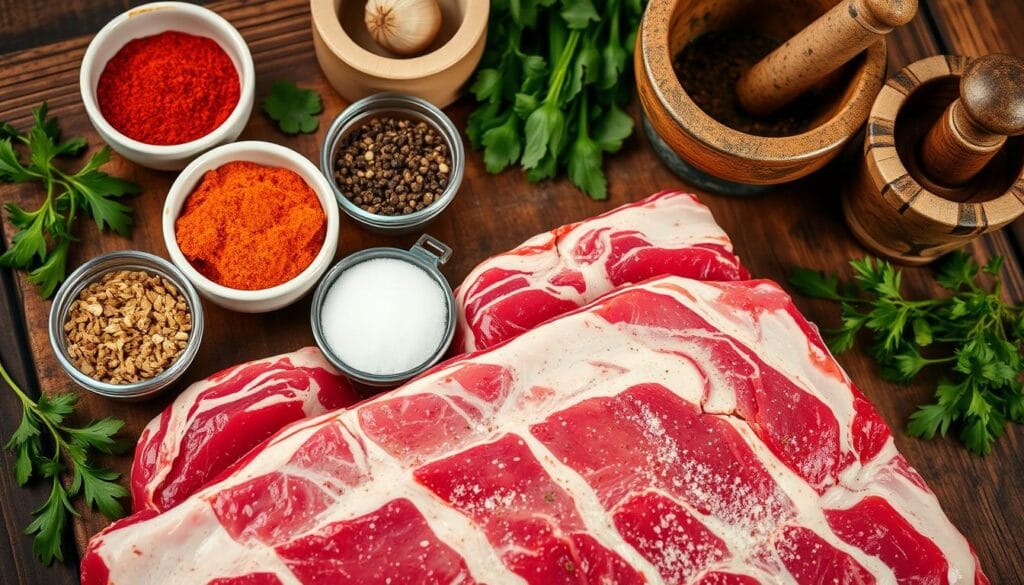
Essential Dry Rub Ingredients
Your rib rub needs a mix of sweet, savory, and spicy. The main ingredients are:
- Brown sugar for sweetness
- Paprika for color and mild heat
- Kosher salt for seasoning
- Black pepper for kick
- Garlic powder for depth
- Chili powder for complexity
Perfect Rub Application Techniques
Here’s how to apply your rib rub to beef ribs:
- Pat the ribs dry with paper towels
- Generously coat all surfaces
- Massage the rub into the meat
- Let the ribs rest for 30-60 minutes before cooking
Marinating Wisdom for Maximum Flavor
While dry rubs work fast, resting the seasoned ribs lets flavors sink in. For the best taste, rub the ribs and refrigerate for 2-4 hours before smoking.
“A great rib rub is like a symphony of flavors dancing on your taste buds” – BBQ Pitmaster
| Ingredient | Quantity | Purpose |
|---|---|---|
| Brown Sugar | 1/4 cup | Adds sweetness and helps caramelization |
| Paprika | 2 tbsp | Provides color and mild heat |
| Kosher Salt | 2 tbsp | Enhances overall flavor |
| Black Pepper | 1 tbsp | Adds spicy undertone |
Mastering Different Cooking Methods for Beef Ribs
Cooking beef ribs needs skill and knowing different techniques. Each method adds unique flavors and textures. This can make your meat go from good to amazing. Let’s look at the top ways to cook smoked ribs, grilled ribs, and braised ribs.

- Smoking Ribs: The slow and low method that adds deep, rich flavors
- Temperature: 225-250°F
- Cooking time: 5-6 hours
- Wood chips recommended: Hickory or oak
- Grilled Ribs: Great for direct heat and quick cooking
- Temperature: 350-400°F
- Cooking time: 1.5-2 hours
- Best for a crispy exterior
- Braised Ribs: Perfect for tender, fall-off-the-bone texture
- Temperature: 300°F
- Cooking time: 2-3 hours
- Needs liquid for moisture
Your choice of cooking method depends on your time, equipment, and flavor preference. Smoked ribs give a traditional BBQ taste. Grilled ribs are quicker. Braised ribs are tender and great for indoor cooking.
“The secret to great ribs is patience and understanding your cooking method.” – Professional BBQ Chef
Pro tip: Always let your ribs rest for 10-15 minutes after cooking. This lets juices spread, making your ribs flavorful and tender.
Sauces and Glazes That Complement Beef Ribs
The right rib sauce can make your barbecue ribs amazing. Finding the perfect sauce is an art. It takes your beef ribs to a new level of taste.
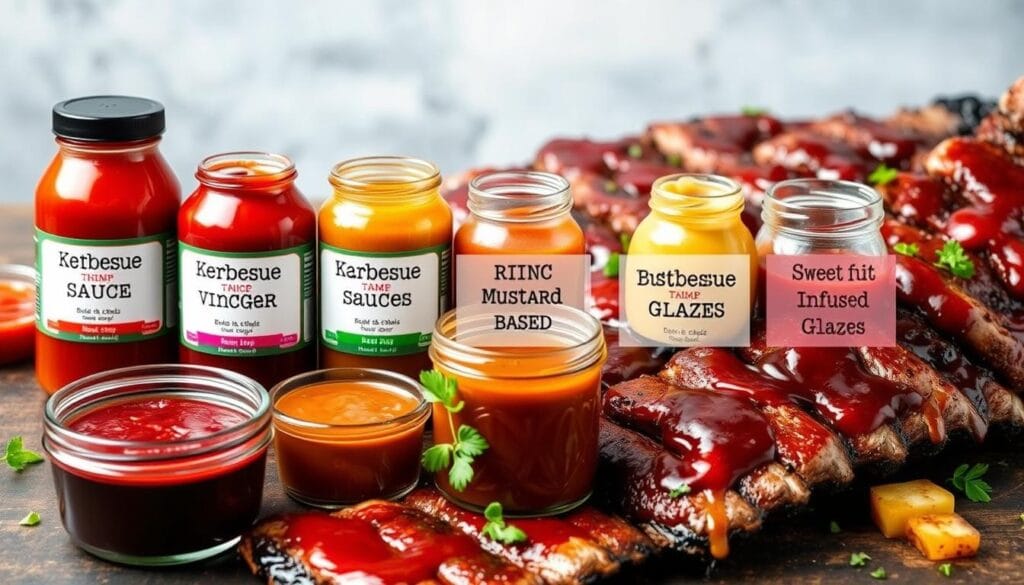
Choosing the right sauce is key. It’s about matching flavors with the meat of beef ribs. Your sauce should boost, not hide, the meat’s natural taste.
Classic BBQ Sauce Recipes
Traditional barbecue ribs need a strong sauce. It should mix sweetness and tanginess well. A classic sauce includes:
- Tomato paste or ketchup base
- Brown sugar for sweetness
- Apple cider vinegar for tang
- Worcestershire sauce
- Smoked paprika
Asian-Inspired Glazes
For a unique twist, try Asian-inspired glazes. These sauces mix exciting flavors. They often have:
- Soy sauce
- Honey
- Ginger
- Garlic
- Sesame oil
Finishing Sauce Techniques
When to apply your sauce matters a lot. For perfectly glazed ribs, try these tips:
- Put sauce on during the last 15-20 minutes of cooking
- Brush thin layers for even coverage
- Let sauce caramelize a bit
“The secret to great ribs is patience and the perfect sauce.” – BBQ Pitmaster
The best rib sauce enhances your beef ribs without overpowering them. Experiment to find your favorite!
Common Mistakes to Avoid When Cooking Beef Ribs
Getting perfect smoked ribs can be tough, even for experts. Many home cooks face big mistakes that make their beef ribs tough and disappointing.

Let’s look at the most common mistakes in cooking beef ribs and how to dodge them:
- Temperature Control Mistakes
Keeping the heat steady is key for grilled ribs. If the temperature goes up and down, your ribs might cook unevenly and get dry. Use a meat thermometer to check the internal temperature.
- Seasoning Errors
Not seasoning enough or seasoning wrong can make your ribs taste bland. Always make a strong dry rub and let the meat soak up the flavors for a while.
- Cooking Time Misconceptions
Don’t rush cooking your ribs or leave them on the grill too long. Cooking them slow and low is the secret to tender, juicy ribs.
“The difference between good and great beef ribs is in the details.” – Professional Pitmaster
Here’s a quick guide to avoid common mistakes in cooking beef ribs:
| Mistake | Solution |
|---|---|
| Overcooking | Use meat thermometer, cook at 225-250°F |
| Skipping Resting | Let ribs rest 10-15 minutes after cooking |
| Wrong Trimming | Remove excess fat, leave some for flavor |
By knowing these common mistakes, you’ll get better at making delicious grilled ribs. Your friends and family will love them.
Conclusion
Mastering beef ribs is an art that combines passion, technique, and creativity. You’ve learned how to pick the right cut and grill it perfectly. This turns ordinary barbecue ribs into unforgettable culinary experiences.
Creating delicious grilled ribs is more than just cooking. It’s about understanding flavor, texture, and the techniques that make each bite special.
Now you can try different cooking styles, rubs, and sauces. Whether you like slow-smoked or quick-grilled ribs, practice is key. Always use fresh, well-marbled cuts from good butchers for the best results.
Start your journey to becoming a beef ribs expert. Every time you grill, you’ll get better. Don’t be shy to try new flavors or styles. Your friends and family will love the meals you make, making every cookout special.
Great beef ribs are more than food; they bring people together. Keep learning, stay curious, and enjoy the journey of becoming a grilling enthusiast.

